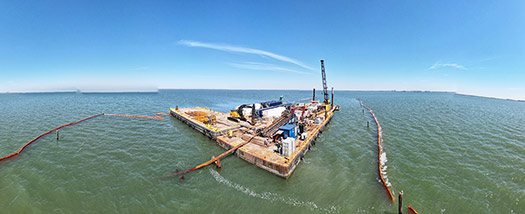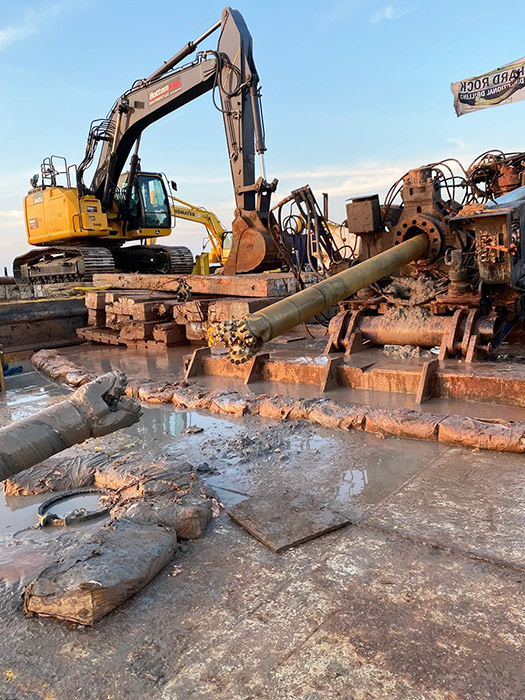January 2024 Vol. 79 No. 1
Features
Crossing the Bay
Barges, intersect technology take 24-inch pipe under busy shipping channel
By Tom Jackson, Contributing Editor
(UI) — West of Houston, the region’s petrochemical infrastructure creates a tangled maze of pipelines, roads, swamps and endangered ecosystems. Performing HDD operations here would challenge any contractor. Add a crossing under the Intercoastal Waterway to the mix – arguably the busiest commercial shipping channel in the United States – and you have a job that is not for the faint of heart.
So, when Texas International Pipeline Systems (TIPS) went looking for an underground contractor to install 24-inch steel pipeline 11 miles underground and underwater, from Texas City to Galveston Island, it turned to three veteran firms. HardRock Infrastructure Services, from San Antonio, was tapped for the HDD work and teamed with Troy Construction, as general contractor, and Campos Engineering.
Underwater intersect
The HDD segments of the project consisted of 16 drills totaling 8.4 miles (43,938 feet). But to get the pipe under Galveston Bay, HardRock completed an 8,174-foot, land-to-bay intersect drill, and two 5,717-foot, barge-to-barge drills, and then a barge-back-to-land drill, said Cory Baker, chief operating officer, at HardRock.
From the refinery at Texas City the first drill was a standard HDD job, followed by a long intersect on land, which was necessary to avoid putting directional drills and support equipment in the middle of a protected wetlands.
The next segment is where things got interesting. From the exit point of the drill on land, HardRock then started drilling to go under Galveston Bay and connect via an intersect operation with a drill rig floating on a barge in the channel.
“The HDD rig in the bay sat on one barge, along with the pumps and reclaimer, while the drill pipe loader sat on another barge,” said Baker.
Additional barges hauled water for the drilling fluid to the HDD rig. “You can’t mix mud with water from the bay because it’s brackish saltwater. You have to haul in freshwater,” he added.
Steady as she goes
With massive oil tankers and commercial ships steaming through the waterway – not to mention wind and tides – maintaining the stability of the drill rig on the barge was the biggest challenge, especially in the deeper water where the supertankers and tugboats throw off enormous wakes.
What Baker calls “spud barges” were positioned alongside the barge and anchored into the seabed to keep the barge in one place and allow it to rise and fall with the constantly changing water levels.
“The ships can raise and lower the water level quickly and we have to be very careful,” he said.
To keep the drill string from flexing too much during operations, HardRock ran 16-inch casing from the edge of the barge down to the sea floor and into underwater trenches about 20-feet deep and 100-feet long dug by barge mounted excavators. By threading the pipe through this casing, HardRock was able to avoid excessive sagging and metal fatigue on the underwater drill string.
“If the barge was moving too much, crews might cease operation, but normally they didn’t have to on this job,” said Baker. “The only time we had to cease is when we were adding a pipe joint and that is just to get the threads lined up.”
As the pilot bores emerged from the water, HardRock used goalpost-like stanchions to guide the exit side tooling onto the barge and coax it into position where the tail string was added and joints made up.
Barge-to barge
After the first land-to-barge intersect job, the next segment was drilled barge-to-barge, but not using the intersect technology. Here, the second barge was used to put the back reamers on.
This segment was originally planned to be open cut performed by Troy. But after looking at the permitting and costs, they decided to drill it. With about 11,000 feet to go, HardRock broke this segment into two 5,500-foot barge-to-barge, single shots. To finalize the job, a hard crossing was completed from the land-side exit hole to the facility.
HardRock might have been able to complete this job without using intersect technology. But the dual rig method just made more sense.
“It would have been a lot riskier,” said Baker. “We did the 5,000-foot shots on the Vermeer 1000/900 base single rig.
“Could we have gone another 3,000 feet to finish those 8,000 footers? Maybe, but it would have been a lot harder on the equipment. Anytime you start getting out to 8,000 feet, it’s safer to do the intersect,” he added.
Another challenge for HardRock’s TIPS job was that much of the drilling mud would be lost underwater. The Houston-Galveston area may contain the largest concentration of petroleum production in the country, but there are still significant environmental requirements to protect wetlands, marshes, oyster reefs and other marine habitats surrounding Galveston Bay. HardRock used NSF-certified mud mixtures, which are environmentally safe.
“We try to run that on every project we do,” said Baker.
Onsite inspection teams monitored the sites and HardRock completed the project with zero environmental incidents.
“At the end of the day, HDD is an environmental solution. We care about the environment and everything we use is safe for the environment,” said Baker.
“It was a very complicated project, but we had our senior project manager looking over it and crew leaders on the rigs the whole time,” he pointed out. “And we worked hand-in-hand with Troy Construction to keep everything scheduled and organized.”
History of innovation
HardRock has been at the forefront of HDD innovation almost from the beginning of the industry. The company’s earliest experience with intersect technology was in the late 2000s.
“Some people thought it was crazy, and the next thing you know everybody was doing them,” said Baker. “When I first got into this industry, 3,000 feet was a long drill. Now we’re doing 13,000- and 14,000-foot drills.
“Around 2010-2011 we did a drill on the Sabine River that was one of the first 11,000-foot drills ever done. That was an intersect job. There’s no doubt in my mind we’ll be doing 20,000-to-25,000-foot drills in the future.”
The HDD portion of the TIPS project was scheduled for 180 days but completed in 130 days. With the assistance from Troy Construction’s land and marine fleet, Campos Engineering and TIPS Management, HardRock successfully completed all drills within scope, time and budget.
“Our crews are amazing,” said Baker. “They work very hard. Given our support from Troy, TIPS and Campos, I would not be afraid to say it was probably one of the best-coordinated projects I've ever been on. This one really felt like a team. We all worked hard together. And I think that's why it was completed the way it was.”
FOR MORE INFORMATION:
HardRock Infrastructure, (210) 403-2086, hardrockis.com
Vermeer Corp., (888) 837-6337, vermeer.com
Brownline, (281) 391 5800, drillguide.com
American Augers, (800) 324-4930, americanaugers.com Augers
American Wireline, (877) 783-3744, americanwireline.com
Equipment, schedule and personnel
HardRock used six maxi-rigs on the TIPS project: Vermeer 220x300S Navigator, Vermeer 330x500, American Auger DD440T, Vermeer 500x500 Navigator and two Vermeer D1000x900 drills.
To guide the intersect drill heads, the crews utilized Tensteer’s High Resolution Steering Tool Probe and the Brownline downhole steering tool based on gyro technology, with American Wireline steering services to complete all pilots. Brownline completed all of the water work and American Wireline completed land sections.
The crew totaled 45 employees who racked up 41,397-man hours with zero incidents.
Advice for those who want to go long
Putting in miles of pipe underground, not to mention a busy shipping channel, is not for the inexperienced. Baker says HDD contractors who want to step up into bigger work like this should first make sure everything is designed correctly and you have the employees and talent to take on the job.
Reputation also matters in the HDD industry. “As an industry we don’t need failed crossings. Those hurt everybody,” said Baker. “This is what we do for a living and it’s all we do. We want to make sure every job is done correctly and completed in a way that takes the environment into consideration, because we want people to understand that HDD is the environmental solution.”
That’s why there’s no shame in calling other HDD contractors for advice. It’s something Baker has done in the past and he’s glad to reciprocate.
“I’m a big proponent of this industry and I don’t want to see anybody fail.”
Double your range with intersects
The benefit of intersect technology is that you don’t have to steer the pilot bit all the way through to the exit point. Instead, two HDD drills start at opposite ends of the bore path and work towards the middle. Sophisticated radar and gyroscopes help the two pilot bits find each other underground. Once they do, one pilot bit is retracted and the other follows the now pre-bored hole up to the exit point.
By using two drills, the effective underground range of the job is doubled. And the final half of the bore is easier to steer and much more accurate than having to push the pilot bit all the way to the exit point.






Comments